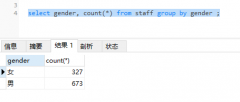Multiplication aggregate operator in SQL(SQL中的乘法聚合运算符)
问题描述
In SQL there are aggregation operators, like AVG, SUM, COUNT. Why doesn't it have an operator for multiplication? "MUL" or something.
I was wondering, does it exist for Oracle, MSSQL, MySQL ? If not is there a workaround that would give this behaviour?
By MUL do you mean progressive multiplication of values?
Even with 100 rows of some small size (say 10s), your MUL(column) is going to overflow any data type! With such a high probability of mis/ab-use, and very limited scope for use, it does not need to be a SQL Standard. As others have shown there are mathematical ways of working it out, just as there are many many ways to do tricky calculations in SQL just using standard (and common-use) methods.
Sample data:
Column
1
2
4
8
COUNT : 4 items (1 for each non-null)
SUM : 1 + 2 + 4 + 8 = 15
AVG : 3.75 (SUM/COUNT)
MUL : 1 x 2 x 4 x 8 ? ( =64 )
For completeness, the Oracle, MSSQL, MySQL core implementations *
Oracle : EXP(SUM(LN(column))) or POWER(N,SUM(LOG(column, N)))
MSSQL : EXP(SUM(LOG(column))) or POWER(N,SUM(LOG(column)/LOG(N)))
MySQL : EXP(SUM(LOG(column))) or POW(N,SUM(LOG(N,column)))
- Care when using EXP/LOG in SQL Server, watch the return type http://msdn.microsoft.com/en-us/library/ms187592.aspx
- The POWER form allows for larger numbers (using bases larger than Euler's number), and in cases where the result grows too large to turn it back using POWER, you can return just the logarithmic value and calculate the actual number outside of the SQL query
* LOG(0) and LOG(-ve) are undefined. The below shows only how to handle this in SQL Server. Equivalents can be found for the other SQL flavours, using the same concept
create table MUL(data int)
insert MUL select 1 yourColumn union all
select 2 union all
select 4 union all
select 8 union all
select -2 union all
select 0
select CASE WHEN MIN(abs(data)) = 0 then 0 ELSE
EXP(SUM(Log(abs(nullif(data,0))))) -- the base mathematics
* round(0.5-count(nullif(sign(sign(data)+0.5),1))%2,0) -- pairs up negatives
END
from MUL
Ingredients:
- taking the abs() of data, if the min is 0, multiplying by whatever else is futile, the result is 0
- When data is 0, NULLIF converts it to null. The abs(), log() both return null, causing it to be precluded from sum()
- If data is not 0, abs allows us to multiple a negative number using the LOG method - we will keep track of the negativity elsewhere
- Working out the final sign
- sign(data) returns
1 for >0,0 for 0and-1 for <0. - We add another 0.5 and take the sign() again, so we have now classified 0 and 1 both as 1, and only -1 as -1.
- again use NULLIF to remove from COUNT() the 1's, since we only need to count up the negatives.
% 2against the count() of negative numbers returns either- --> 1 if there is an odd number of negative numbers
- --> 0 if there is an even number of negative numbers
- more mathematical tricks: we take 1 or 0 off 0.5, so that the above becomes
- --> (
0.5-1=-0.5=>round to -1) if there is an odd number of negative numbers - --> (
0.5-0= 0.5=>round to 1) if there is an even number of negative numbers - we multiple this final 1/-1 against the SUM-PRODUCT value for the real result
- sign(data) returns
这篇关于SQL中的乘法聚合运算符的文章就介绍到这了,希望我们推荐的答案对大家有所帮助,也希望大家多多支持编程学习网!
本文标题为:SQL中的乘法聚合运算符


基础教程推荐
- MySQL 5.7参照时间戳生成日期列 2022-01-01
- while 在触发器内循环以遍历 sql 中表的所有列 2022-01-01
- CHECKSUM 和 CHECKSUM_AGG:算法是什么? 2021-01-01
- 带有WHERE子句的LAG()函数 2022-01-01
- 带更新的 sqlite CTE 2022-01-01
- 从字符串 TSQL 中获取数字 2021-01-01
- MySQL根据从其他列分组的值,对两列之间的值进行求和 2022-01-01
- ORA-01830:日期格式图片在转换整个输入字符串之前结束/选择日期查询的总和 2021-01-01
- 如何在 CakePHP 3 中实现 INSERT ON DUPLICATE KEY UPDATE aka upsert? 2021-01-01
- 使用 VBS 和注册表来确定安装了哪个版本和 32 位 2021-01-01

















